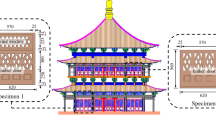Abstract
Traditional timber structures are well known as an efficient aseismic structure. In order to clearly understand the reasons for the good performance of the Chinese traditional timber structures during earthquakes, the energy dissipation mechanism of a Chinese traditional timber structure was studied by shaking table tests in this paper. A model at a 1:6 geometric scale was manufactured with the same fabrication methods to the prototype, a Chinese timber tower built in 1834. The model was subjected to 4 different horizontal waves with increasing intensity. The damage patterns, dynamic characteristics, and dynamic responses were obtained. The energy dissipation mechanism of the traditional timber structure was analysed based on the principle of energy balance. A new damage assessment model based on energy dissipation was also proposed and the results showed a good agreement with that given by an existing model.


















Similar content being viewed by others
References
Ahmad N, Ali Q, Umar M (2012) Simplified engineering tools for seismic analysis and design of traditional Dhajji-Dewari structures. Bull Earthq Eng 10(5):1503–1534
Benavent-Climent A, Escolano-Margarit D, Morillas L (2014a) Shake-table tests of a reinforced concrete frame designed following modern codes: seismic performance and damage evaluation. Earthq Eng Struct Dyn 43(6):791–810
Benavent-Climent A, Morillas L, Escolano-Margarit D (2014b) Seismic performance and damage evaluation of a reinforced concrete frame with hysteretic dampers through shake-table tests. Earthq Eng Struct Dyn 43(15):2399–2417
Bothara JK, Dhakal RP, Mander JB (2010) Seismic performance of an unreinforced masonry building: an experimental investigation. Earthq Eng Struct Dyn 39(1):45–68
Chen ZY, Zhu EC, Lam F, Pan JL (2014) Structural performance of Dou-Gong brackets of Yingxian Wood Pagoda under vertical load—an experimental study. Eng Struct 80:274–288
Choi IK, Seo JM (2002) Estimation of historical earthquake intensities and intensity–PGA relationship for wooden house damages. Nucl Eng Des 212(1):165–182
Clough RW, Penzien J (2013) Dynamics of Structures. Mc Graw-Hill Inc, New York
Crayssac E, Song XB, Wu YJ, Li K (2018) Lateral performance of mortise-tenon jointed traditional timber frames with wood panel infill. Eng Struct 161(2018):223–230
D’Ayala DF, Tsai PH (2008) Seismic vulnerability of historic Dieh-Dou timber structures in Taiwan. Eng Struct 30(8):2101–2113
Fang DP, Iwasaki S, Yu M, Shen QP, Miyamoto Y, Hikosaka H (2001) Ancient Chinese timber architecture. I: experimental study. J Struct Eng 127(11):1348–1357
Fujita K, Kawai N, Minowa C (2006) Shaking table test and earthquake response monitoring of traditional Japanese timber pagoda. In: 9th world conference on timber engineering, Portland
Gao DF, Zhao HT, Xue JY (2008) Experimental study on seismic behavior of bucket and mortise joints in wooden buildings. J Nat Disa 17(2):58–64
Gao DF, Liu J, Li F, Deng HX, Yang Y, Sui Y (2014) The researches on shaking table test of Yongning Gate embrasure watch-tower of **’an City wall. Earthq Eng Eng Dyn 34(5):140–149
Gao YL, Zhong T, Ye LY, Miao Y, Su HX, Yu WZ (2016) Shaking table tests of mortise-tenon joints of a traditional Chuan-Dou wood structure attached with viscoelastic dampers. China Civ Eng J 49(2):59–68
GB 1927~1943–91 (1992) Testing methods for physical and mechanical properties of wood. Architecture and Building Press, Chinese Academy of Forestry, Bei**g
GB 50011–2010 (2010) Code for seismic design of building. Architecture and Building Press, Ministry of Housing and Urban-Rural Construction of the People’s Republic of China, Bei**g
Ghobarah A, Abou-Elfath H, Biddah A (1999) Response-based damage assessment of structures. Earthq Eng Struct Dyn 28(1):79–104
Housner GW (1956). Limit design of structures to resist earthquakes. In: Proceedings of the first world conference on earthquake engineering, Berkeley CA
Hsu MF, Yeo SY, Shang PY (2009) Full-scale experiment on Taiwanese traditional timber frame. In: Proceedings of the 11th international conference on non-conventional materials and technologies, Bath
Ji XD, Fenves GL, Kajiwara K, Nakashima M (2011) Seismic damage detection of a full-scale shaking table test structure. J Struct Eng 137(1):14–21
Kawai N (1996) Column rocking resistance in Japanese traditional timber buildings. In: Procedure of the international wood engineering conference
King WS, Yen JYR, Yen YNA (1996) Joint characteristics of traditional Chinese wooden frames. Eng Struct 18(8):635–644
Sabnis GM, Harris HG, White RN, Mirza MS, Klingner RE (1983) Structural modeling and experimental techniques. Prentice-Hall, Englewood Cliffs
Seo J, Choi I, Lee J (2015) Experimental study on the aseismic capacity of a wooden house using shaking table. Earthq Eng Struct Dyn 28(10):1143–1162
Shen J, Akba B (1999) Seismic energy demand in steel moment frames. J Earthq Eng 3(4):519–559
Suzuki Y, Maeno M (2010) Structural mechanism of traditional wooden frames by dynamic and static tests. Struct Control Health Monit 13(1):508–522
Uang CM, Bertero VV (1990) Evaluation of seismic energy in structures. Earthq Eng Struct Dyn 19(1):77–90
Vieux-Champagne F, Sieffert Y, Grange S, Nko’ol CB, Bertrand E, Duccini JC, Daudeville L (2017) Experimental analysis of a shake table test of timber-framed structures with stone and earth infill. Earthq Spectra 33(3):1075–1100
Wang H, Scanlon A, Shang S, He F (2013) Comparison of seismic experiments on traditional Chinese wood structures and light wood-framed structures. J Struct Eng 139(11):2038–2043
Wang Y, Wang M, Liu K, Pan W, Yang XD (2017) Shaking table tests on seismic retrofitting of rammed-earth structures. Bull Earthq Eng 15(3):1037–1055
Wu YJ, Song XB, Gu XL, Luo L (2018) Dynamic performance of a multi-story traditional timber pagoda. Eng Struct 159:277–285
**e QF, Zhang LP, Li S, Zhou WJ, Wang L (2017) Cyclic behavior of Chinese ancient wooden frame with mortise–tenon joints: friction constitutive model and finite element modelling. J Wood Sci 9:1–12
Xue JY, Zhang FL, Zhao HT (2012a) Shaking table test of an ancient timber structure strengthened with CFRP. China Civ Eng J 45(11):95–104
Xue JY, Zhang FL, Zhao HT, **e QF, Sui Y, Zhang XC (2012b) Potential and energy dissipation-based seismic damage evaluation of ancient timber structure. J Build Struct 33(8):127–134
Yang J, Chen Y, Jiang H, Lu X (2010) Shaking table tests on China pavilion for EXPO 2010 Shanghai China. Struct Des Tall Spec Build 21(4):265–282
Yao K, Zhao HT (2006) Study on the mechanism of sliding friction shock isolation between timber column and plinth in historical buildings. Eng Mech 23(8):127–131
Yu Q, Meng SP, Wu J (2011) Deformation and energy-based seismic damage evaluation of reinforced concrete structures. China Civ Eng J 44(5):16–23
Zhang XC, Xue JY, Zhao HT, Sui Y (2011) Experimental study on Chinese ancient timber-frame building by shaking table test. Struct Eng Mech 40(4):46–47
Zhang FL, Zhao HT, Xue JY, Ma H, Zhang XC (2012) The analysis of dynamic properties on the roof-beams system in ancient timber buildings. Eng Mech 29(8):184–188
Zhou Y, Lu XL (2016) Method and technology for shaking table model test of building structures. Science Press, Bei**g
Acknowledgements
This research project was performed by many researchers. The help of the students and the entire laboratory staff at the **’an University of Architecture and Technology is sincerely appreciated. The authors gratefully acknowledge financial support from the National Natural Science Foundation of China (Grant No. 51878550) and the National Key Research and Development Program of China (Grant No. 2017YFC0703507). The work was also supported by the Natural Science Basic Research Program of Shaanxi Province of China (Grant No. 2016ZDJC-23) and the Key Laboratory Project of Education Department of Shaanxi Provincial Government (Grant No. 2014SZS04-P04).
Author information
Authors and Affiliations
Corresponding author
Rights and permissions
About this article
Cite this article
**e, Q., Wang, L., Zhang, L. et al. Seismic behaviour of a traditional timber structure: shaking table tests, energy dissipation mechanism and damage assessment model. Bull Earthquake Eng 17, 1689–1714 (2019). https://doi.org/10.1007/s10518-018-0496-4
Received:
Accepted:
Published:
Issue Date:
DOI: https://doi.org/10.1007/s10518-018-0496-4




